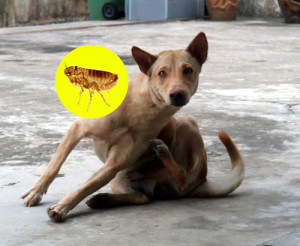What Attracts Fleas to My Pets?
By Chris Williams on July 4, 2014.
I’ve treated my dog and cat for fleas before and things seem to be good for awhile, then I’ll notice them scratching again and sure enough, they’ve got fleas! Where did the fleas come from and why are they attracted to my poor pets?—J.P., Hudson MA
 Fleas Like a Warm, Hairy Body
Fleas Like a Warm, Hairy Body
Fleas are attracted to your pets because your pets are warm, hairy, and emit carbon dioxide when they breathe. Fleas key in on that combination and, to a flea, it says “Bloodmeal!”
The same fleas that feed on pets will feed on humans, but people are definitely not their first choice, probably because we are not hairy enough (nothing for fleas to grab onto) and we can reach and destroy fleas on our body. You find most of the fleas on your pets safely nestled in hairs along their spine, just out of reach of the pet’s mouth.
There are many ways your pets can get reinfested with fleas after they’ve been treated. They could pick up new fleas from other pets, (even at the vet’s). Or they can pick up fleas outdoors in your yard, or in a nearby park. This outside connection works in two ways:
- when your pet is outside, fleas on the animal lay eggs that drop to the ground. After the larvae develop and turn into adult fleas, those adults can jump back onto your pet when it goes outside
- other animals like raccoons and opossums, and even other pets, also have fleas that are laying eggs outside. If your pets frequent the same areas, they can get fleas left behind by other animals.
Expect More Fleas Unless You Have Your Home Treated, Too
Finally (and you won’t want to hear this), but the most likely way that your pets have become reinfested is from your own home. Unless you had your home treated for fleas at the same time that you treated your pets, fleas will continue to develop in your pets’ beds and resting areas. When eggs drop off of the female flea, they end up where your pet spends most of its time. The eggs hatch into flea larvae that feed on adult flea feces (dried blood) which also drops into your pet’s resting area. Soon enough, the larvae pupate and another generation of hungry adult fleas emerges. The time it takes for your pet’s flea treatment to wear off is probably about the same amount of time it takes for a new crop of fleas to develop from egg to adult.
This time when you treat your pets for fleas, call a professional exterminator like Colonial Pest to have the flea areas in your home treated as well. Ask the technician whether pet areas in your yard should be treated, too. If you can remember that part of the flea life cycle is not on your pet but in your home, your pets should soon be flea-free.
Photo credit: kat m research / Foter / Creative Commons Attribution-ShareAlike 2.0 Generic (CC BY-SA 2.0)
Photo credit: AlanLZY / Foter / Creative Commons Attribution-ShareAlike 2.0 Generic (CC BY-SA 2.0)